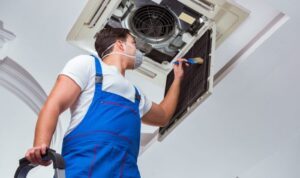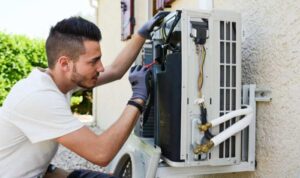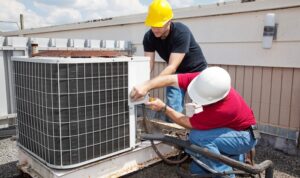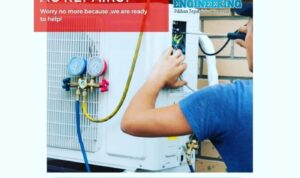Repairing heating and cooling systems is essential for maintaining a comfortable indoor environment. This article delves into the intricacies of troubleshooting common issues, discussing when to seek professional help, and sharing tips for preventive maintenance. Let's explore the world of heating and cooling repairs together.
Understanding Heating and Cooling Systems
Heating and cooling systems are essential for maintaining a comfortable indoor environment, especially during extreme weather conditions. Let's delve into the basic components of a heating system and the key components of a cooling system to understand how they work.
Heating System Components:
- The furnace: This is the central component of a heating system that generates heat by burning fuel or using electricity.
- Thermostat: It controls the temperature by signaling the furnace to turn on or off based on the desired temperature setting.
- Ductwork: This system of ducts distributes the heated air throughout the building to ensure even heating.
- Heat exchanger: It transfers heat from the furnace to the air that is circulated throughout the building.
Cooling System Components:
- Air conditioner: The main component of a cooling system that removes heat from indoor air and blows cool air into the space.
- Evaporator coil: This coil absorbs heat from the indoor air as it passes over, cooling it down before being circulated back into the building.
- Compressor: It circulates refrigerant between the indoor and outdoor units to transfer heat effectively.
- Condenser coil: This coil releases the heat absorbed from indoor air to the outside environment.
Heating systems are designed to generate heat to warm indoor spaces, while cooling systems work to remove heat from indoor air to create a cooler environment. Both systems play crucial roles in maintaining a comfortable temperature within a building, ensuring the well-being and comfort of its occupants.
Common Heating System Issues

Heating systems are essential for keeping our homes warm and comfortable, especially during the colder months. However, like any other mechanical system, heating systems can encounter various issues that may disrupt their functionality. It is important to be aware of these common problems, the significance of regular maintenance, and how to troubleshoot heating system issues.
1. Uneven Heating
Uneven heating is a common issue where certain areas of the house are warmer than others. This can be caused by blocked vents, dirty filters, or issues with the ductwork. Regularly cleaning and replacing filters, as well as ensuring proper airflow, can help alleviate this problem.
2. No Heat or Insufficient Heat
If your heating system is not producing any heat or is not providing enough warmth, it could be due to a malfunctioning thermostat, pilot light issues, or a faulty furnace. Checking the thermostat settings, ensuring the pilot light is lit, and inspecting the furnace for any visible damage can help diagnose the issue.
3. Strange Noises
Strange noises coming from your heating system, such as banging, rattling, or squealing sounds, can indicate underlying issues like loose components, clogged burners, or worn-out belts. Regular maintenance and timely repairs can prevent these noises and ensure the system operates smoothly.
4. Short Cycling
Short cycling occurs when the heating system frequently turns on and off in short intervals, leading to energy wastage and potential wear and tear. This could be due to a clogged filter, improper sizing of the system, or a malfunctioning thermostat.
Addressing the root cause can help resolve this issue.
5. High Energy Bills
If you notice a sudden spike in your energy bills without a corresponding increase in usage, it could indicate that your heating system is working inefficiently. Regular maintenance, such as cleaning and tuning the system, can improve its efficiency and reduce energy costs.
Common Cooling System Issues
When it comes to cooling systems, several common issues can arise that may affect their performance. Regular maintenance is crucial to prevent these problems and ensure the efficiency of your cooling system. Let's explore some of the most common cooling system issues and how to troubleshoot them.
Refrigerant Leaks
Refrigerant leaks are a common problem in cooling systems and can result in reduced cooling capacity. If you notice that your system is not cooling as effectively as before, it may be due to a refrigerant leak. To troubleshoot this issue, you should contact a professional HVAC technician to locate and repair the leak, as handling refrigerant can be dangerous and requires expertise.
Frozen Evaporator Coils
Another common issue in cooling systems is frozen evaporator coils, which can prevent proper airflow and cooling. This can be caused by restricted airflow, dirty coils, or low refrigerant levels. To troubleshoot this problem, you can check and clean the coils, change the air filters regularly, and ensure proper airflow around the unit.
Faulty Compressor
A faulty compressor can also cause cooling system issues, such as inadequate cooling or complete system failure. If you hear unusual noises coming from the compressor or notice that the system is not cooling effectively, the compressor may be the culprit.
Troubleshooting this problem involves checking the electrical connections, ensuring proper lubrication, and contacting a professional for repair or replacement if needed.
Electrical Problems
Electrical problems, such as faulty wiring or malfunctioning components, can also impact the performance of cooling systems. If your system is not turning on or experiencing frequent power issues, it may be due to electrical problems. Troubleshooting electrical issues requires expertise and should be handled by a qualified technician to ensure safety and proper repair.
Repairing Heating Systems

When it comes to repairing a faulty heating system, there are several steps involved that can help diagnose and fix the issue. It's important to follow a systematic approach to ensure that the problem is properly identified and resolved.
Steps for Repairing a Faulty Heating System:
- Check the Thermostat: Ensure that the thermostat is set correctly and functioning properly. Replace the batteries if needed.
- Inspect the Air Filters: Dirty air filters can restrict airflow and cause the system to work harder. Replace or clean the filters regularly.
- Check the Pilot Light: If you have a gas furnace, make sure the pilot light is lit. If not, follow the manufacturer's instructions to relight it.
- Inspect the Ductwork: Check for any leaks or blockages in the ductwork that may be hindering the airflow. Seal leaks and clear any obstructions.
- Test the Blower Motor: Make sure the blower motor is running smoothly and not making any strange noises. Clean and lubricate the motor as needed.
When to Consider Professional Help for Heating System Repairs:
- If you are unable to identify the issue or perform the necessary repairs yourself.
- When dealing with complex heating system components that require specialized tools or knowledge.
- If there is a risk of causing further damage or harm by attempting to repair the system without professional assistance.
Tips for Maintaining a Heating System:
- Schedule regular maintenance check-ups with a professional HVAC technician to ensure optimal performance.
- Keep the area around the heating system clean and free of debris to prevent airflow obstructions.
- Replace air filters regularly to maintain good indoor air quality and prevent strain on the system.
- Consider installing a programmable thermostat to regulate temperature settings and improve energy efficiency.
Repairing Cooling Systems

When it comes to repairing a faulty cooling system, there are several steps involved to ensure it is back up and running efficiently.
Steps in Repairing Cooling Systems
- Start by checking the thermostat settings to make sure they are correctly configured for cooling mode.
- Inspect the air filter and replace it if it is dirty or clogged, as this can restrict airflow.
- Check the condenser unit outside to see if it is dirty or blocked by debris. Clean the unit if necessary to improve airflow.
- Inspect the refrigerant levels and look for any leaks. If there is a refrigerant leak, it should be repaired by a professional.
- Examine the evaporator coil and ensure it is clean and free of any obstructions.
- If the cooling system still does not work after these steps, it may be time to call a professional for further diagnosis and repair.
When to Consider Professional Help for Cooling System Repairs
If you are unable to identify the issue with your cooling system or if the repairs required are beyond your expertise, it is best to seek professional help. Professional technicians have the knowledge and tools to diagnose and fix complex cooling system problems effectively.
Tips for Maintaining a Cooling System
- Regularly clean or replace the air filter to ensure proper airflow and efficiency.
- Keep the area around the outdoor unit clear of debris and vegetation to maintain good airflow.
- Schedule annual maintenance checks with a professional technician to keep the cooling system in optimal condition.
- Monitor the thermostat settings and adjust them as needed to maintain a comfortable indoor temperature without overworking the system.
- Address any strange noises, odors, or performance issues promptly to prevent further damage to the cooling system.
Last Point
In conclusion, understanding the nuances of heating and cooling systems is crucial for ensuring optimal performance. By following the steps Artikeld in this guide, you'll be better equipped to handle any issues that may arise. Keep your systems running smoothly and enjoy a cozy atmosphere year-round.
FAQ Resource
How often should I change the air filters in my heating system?
You should change the air filters in your heating system every 1-3 months, depending on usage and filter type.
What are some signs that indicate a problem with my cooling system?
Signs include weak airflow, strange noises, and uneven cooling throughout your home.
Can I troubleshoot a faulty heating system on my own?
Some basic troubleshooting steps include checking the thermostat settings and ensuring the system has power.


![[Free] Annual Air Conditioner Maintenance Checklist Excel Format [Free] Annual Air Conditioner Maintenance Checklist Excel Format](https://ac.viralsumsel.com/wp-content/uploads/2025/06/Annual-Maintenance-Contract-for-AC-300x178.jpg)



